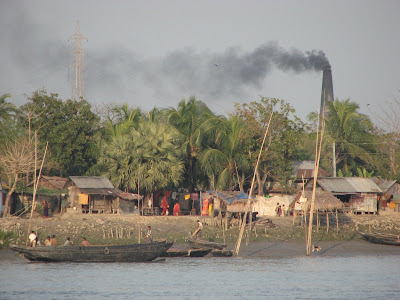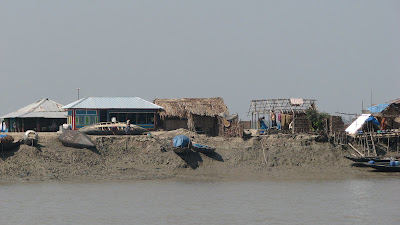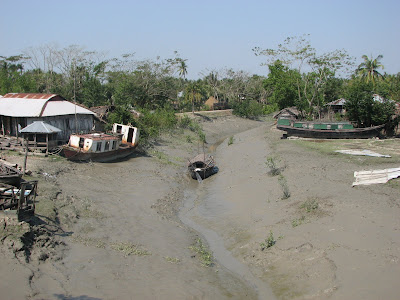
I have this terrible habit of trailing off at the end. When I returned home I didn't want to be completely "back". But I have so much more to tell, so, nearly a month after my return to New York, I bring you more photos and a bit of the story from my brief glimpse into Bangladesh.
This place in the mangrove forests is what I believe to be a most unique place on planet earth. Unimaginably pristine, beautiful from afar and at close inspection, ecologically complex and hardly touched by humans, it touched me profoundly.
We took a small wooden boat through the creek and landed on some sandy ground and I walked for the first time on land formed by the roots of the mangroves. We hiked for a short while, about 2km across a savannah, then through some rough terrain of trees broken by the cyclone last December. We arrived at a silver, crescent shaped beach. I kicked off my shoes and the sand felt like soft velvet. Tiny sand crabs made intricate patterns with beads of sand across the entire beach. I rolled up my jeans and walked into the Bay of Bengal. The water shimmered like crystals and the fine sand turned to dense mud as I walked further and further out; still the waters were shallow.


All rivers that originate in the Himalayas, travel through India, Bhutan and Bangladesh, converge near Dhaka, then spread and distribute in an elaborate delta that is Bangladesh. The Sundarbans mangrove forest is where those sacred, fresh waters meet the salty ocean. Mangroves are unique trees that thrive in the place where salty meets sweet water. Their roots draw in salt and excrete it through their leaves, encouraging other plant life, shellfish, birds, Bengal tigers, deer, and more to live, thus creating one of the most complex ecosystems on earth.
I felt humbled and suddenly needed to immerse myself in this sacred water that had traveled so far, been tainted and cleansed, provided cleansing, provided life, and is the source of life. I left my clothes on the beach and lay in the waters. I thought about the mud and the homes caked and made structural with this earth. I thought about the glorious mangroves, making life possible, protecting the vulnerable population of Bangladesh from cyclones, preventing erosion of the entire nation, so close to sea level, so precariously sited. I felt how small we all are in contrast to nature and these great waters that we take for granted. Gandhi said, “use water as you would milk,” and I imagined rivers of milk.
I knew at that moment that my journey had come to an end. I could go home. I had been to the source of the water- the beginning and the end. I had seen places parched, yet full of life in the desert, and places inundated with too much water, still surviving every day.
I couldn’t stay and would never stay in a land that wasn’t my own. I needed to get back home and embrace my own land, water, and people. I will spend my lifetime doing this. But I will return to India as my muse.



























